The Effect of Heat Source Path on Thermal Evolution during Electro-Gas Welding of Thick Steel Plates
Abstract
1. Introduction
2. Materials and Model Description
2.1. Electro-Gas Welding Experiments
2.2. Three-Dimensional EGW Model for the Numerical Simulation
- The weld region close to the weld heat source has a larger temperature gradient and, hence, was divided into a finer grid (minimum mesh tetrahedral edge length 7.67 mm).
- A coarser mesh (maximum mesh tetrahedral edge length 24.24 mm) was applied to the base steel plate areas far away from the heat source, where a smaller change in thermal gradients occurred.
2.3. Heat Source Movement Path
2.3.1. Heat Source Model
2.3.2. Heat Source Movement Path
- 1.
- Linear path heat source
- 2.
- Sinusoidal path heat source
- 3.
- Oscillate-stop heat source
3. Model Verification via Experiment
- (1)
- As shown in Figure 9b, the application of the linear heat source path did not cause sufficiently high temperatures to melt the top and bottom of the joint; only the centre part of joint is melted, which differs to the experimental observation.
- (2)
- (3)
- The application of the oscillate-stop path leads to a fully melted weld joint in the thickness direction. Additionally, the fusion line extended to the outside of the welding groove base metal near the fusion is melted to form a solid joint, and the area covered by the fusion line is similar to that observed in the experiments.
4. Evolution of Thermal Profile in Heat Affected Zone
4.1. Simulated Heat Source Paths
4.2. Thermal Cycles in Heat Affected Zone
5. Recommended Heat Source Path Model for Simulating EGW Welding of Thick Steel Plates
- 20 mm, 25 mm thickness steel plates—using the linear path (Figure 12a,b);
- 30 mm, 35 mm thickness steel plates—using sinusoidal path (Figure 12c,d);
- 35 mm and 40 mm thick steel plates—using oscillate-stop path (Figure 12e,f).
6. Conclusions
- Three different types of heat source path models (linear, sinusoidal function and oscillate-stop) were implemented to simulate the EGW process of marine steel with a heat input of 157 kJ/cm.
- For EGW welding of 30 mm thickness steel plates, the model using the oscillate heat source path predicted a more accurate thermal profile (the shape of melt pool and the fusion line) than those using the sinusoidal and linear heat source paths.
- The applicable heat source paths for modelling the EGW process of steel plates with different thicknesses were investigated. The linear path model can be used for simulating steel plate thickness up to 20 mm, a maximum thickness of 30 mm is appropriate for the sinusoidal path, and a maximum thickness of 35 mm is appropriate for the oscillate-stop path in EGW welding, with a heat input of 157 kJ/cm.
Author Contributions
Funding
Institutional Review Board Statement
Informed Consent Statement
Data Availability Statement
Acknowledgments
Conflicts of Interest
References
- Ichimiya, K.; Sumi, H.; Hirai, T. 460 MPa Yield Strength Class Steel Plate with JFE EWEL® Technology for Large Heat Input Welding. JFE Tech. Rep. 2008, 5, 7–12. [Google Scholar]
- Kaplan, M.B.; Solomon, S. A coming boom in commercial shipping? The potential for rapid growth of noise from commercial ships by 2030. Mar. Policy 2016, 73, 119–121. [Google Scholar] [CrossRef]
- Sasaki, K.; Suda, K.; Motomatsu, R.I.; Hashiba, Y.; Ohkita, S.; Imai, S. Development of Two-electrode Electro-gas Arc Welding Process. Shinnittetsu Giho 2004, 90, 57–64. [Google Scholar]
- Fritzsche, A.; Avilov, V.; Gumenyuk, A.; Hilgenberg, K.; Rethmeier, M. High power laser beam welding of thick-walled ferromagnetic steels with electromagnetic weld pool support. Phys. Procedia 2016, 83, 362–372. [Google Scholar] [CrossRef][Green Version]
- Wang, G.; Li, J.B.; Sha, Y.Z.; Ma, J. Study on the penetration of electrogas welding. Weld. Technol. 2002, 5, 8–9. [Google Scholar]
- Eakkachai, W.; Koei, H.; Motomichi, Y.; Kenji, S.; Kota, K.; Tadakazu, T.; Hiroshi, Y.; Tsutomu, F.; Shin, N.; Tetsuro, N.; et al. Welding phenomena during vertical welding on thick steel plate using hot-wire laser welding method. Proc. Weld. Soc. 2015, 33, 143s–147s. [Google Scholar]
- Haelsig, A.; Mayr, P. Energy balance study of gas-shielded arc welding processes. Weld. World 2013, 57, 727–734. [Google Scholar] [CrossRef]
- Bai, X.; Colegrove, P.; Ding, J.; Zhou, X.; Diao, C.; Bridgeman, P.; Hönnige, J.R.; Zhang, H.; Williams, S. Numerical analysis of heat transfer and fluid flow in multilayer deposition of PAW-based wire and arc additive manufacturing. Int. J. Heat Mass Transf. 2018, 124, 504–516. [Google Scholar] [CrossRef]
- Aucott, L.; Huang, D.; Dong, H.B.; Wen, S.W.; Marsden, J.A.; Rack, A.; Cocks, A.C.F. Initiation and growth kinetics of solidification cracking during welding of steel. Sci. Rep. 2017, 7, 40255. [Google Scholar] [CrossRef]
- Aucott, L.; Huang, D.; Dong, H.B.; Wen, S.W.; Marsden, J.; Rack, A.; Cocks, A.C.F. A Three-stage mechanistic model for solidification cracking during welding of steel. Met. Mater. Trans. A 2018, 49, 1674–1682. [Google Scholar] [CrossRef]
- Hwang, S.-Y.; Kim, Y.; Lee, J.-H. Finite element analysis of residual stress distribution in a thick plate joined using two-pole tandem electro-gas welding. J. Mater. Process. Technol. 2016, 229, 349–360. [Google Scholar] [CrossRef]
- Xu, G.; Pan, H.; Wang, J. Numerical analysis model of temperature profile in swing-arc narrow gap GMAW welding. Thansactions China Weld. Inst. 2017, 38, 55–60. (In Chinese) [Google Scholar]
- Yuan, S.; Liu, W.; Li, L.; Jiang, X. Heat source model of temperature profile in swing-arc narrow gap MAG welding considering sidewall fusion. Thansactions China Weld. Inst. 2018, 39, 95–99. (In Chinese) [Google Scholar]
- Pereira, H.A.D.S.; Rodrigues, M.C.; Firmino, J.V.L.D.C. Implementation of weave patterns by path parameterization in the simulation of welding processes by the finite element method. Int. J. Adv. Manuf. Technol. 2019, 104, 477–487. [Google Scholar] [CrossRef]
- Wang, Z.; Oliveira, J.P.; Zeng, Z.; Bu, X.; Peng, B.; Shao, X. Laser beam oscillating welding of 5A06 aluminum alloys: Microstructure, porosity and mechanical properties. Opt. Laser Technol. 2019, 111, 58–65. [Google Scholar] [CrossRef]
- Guo, Z.; Saunders, N.; Schillé, J.; Miodownik, A. Material properties for process simulation. Mater. Sci. Eng. A 2009, 499, 7–13. [Google Scholar] [CrossRef]
- Saunders, N.; Guo, U.K.Z.; Li, X.; Miodownik, A.P.; Schillé, J.-P. Using JMatPro to model materials properties and behavior. JOM 2003, 55, 60–65. [Google Scholar] [CrossRef]
- Rosenthal, D. The theory of moving sources of heat and its application of metal treatments. Trans. ASME 1946, 68, 849–866. [Google Scholar]
- Lecoanet, A.; Ivey, D.; Henein, H. Simulation of the temperature profile during welding with COMSOL multiphysics® software using Rosenthal’s approach. In Proceedings of the 2014 COMSOL, Cambridge, UK, 17 September 2014. [Google Scholar]
- Wang, H.X.; Sun, J.S.; Wei, Y.H.; Zheng, Y.Y. Simulation of GMAW thermal process based on string heat source model. Sci. Technol. Weld. Join. 2005, 10, 511–520. [Google Scholar] [CrossRef]
- Eagar, T.; Tsai, N. Temperature fields produced by traveling distributed heat sources. Weld. J. 1983, 62, 346–355. [Google Scholar]
- Rouquette, S.; Guo, J.; Le Masson, P. Estimation of the parameters of a Gaussian heat source by the Levenberg–Marquardt method: Application to the electron beam welding. Int. J. Therm. Sci. 2007, 46, 128–138. [Google Scholar] [CrossRef]
- Fu, G.; Gu, J.; Lourenco, M.I.; Duan, M.; Estefen, S.F. Parameter determination of double-ellipsoidal heat source model and its application in the multi-pass welding process. Ships Offshore Struct. 2014, 10, 204–217. [Google Scholar] [CrossRef]
- Goldak, J.; Chakravarti, A.; Bibby, M. A new finite element model for welding heat sources. Metall. Trans. B 1984, 15, 299–305. [Google Scholar] [CrossRef]
- Podder, D.; Mandal, N.; Das, S. Heat source modeling and analysis of submerged arc welding. Weld. J. 2014, 93, 183–191. [Google Scholar]
- Kik, T. Computational techniques in numerical simulations of arc and laser welding processes. Materials 2020, 13, 608. [Google Scholar] [CrossRef] [PubMed]
- Kik, T.; Górka, J. Numerical simulations of laser and hybrid S700MC T-joint welding. Materials 2019, 12, 516. [Google Scholar] [CrossRef] [PubMed]
- Kik, T. Heat source models in numerical simulations of laser welding. Materials 2020, 13, 2653. [Google Scholar] [CrossRef] [PubMed]
- Hashemzadeh, M.; Chen, B. Comparison between different heat sources types in thin-plate welding simulation. In Developments in Maritime Transportation and Exploitation of Sea Resources; Taylor & Francis: Abingdon, UK, 2013; pp. 329–335. [Google Scholar]
- Tong, M.; Duggan, G.; Liu, J.; Xie, Y.; Dodge, M.; Aucott, L.; Dong, H.; Davidchack, R.L.; Dantzig, J.; Barrera, O.; et al. Multiscale, multiphysics numerical modeling of fusion welding with experimental characterization and validation. JOM 2012, 65, 99–106. [Google Scholar] [CrossRef]
- Cai, Z.; Wu, S.; Lu, A.; Zhao, H.; Shi, Q. Line Gauss heat source model: An efficient approach for numerical welding simulation. Sci. Technol. Weld. Join. 2001, 6, 84–88. [Google Scholar] [CrossRef]
- Norman, A.F.; Ducharme, R.; Mackwood, A.; Kapadia, P.; Prangnell, P.B. Application of thermal modelling to laser beam welding of aluminium alloys. Sci. Technol. Weld. Join. 1998, 3, 260–266. [Google Scholar] [CrossRef]
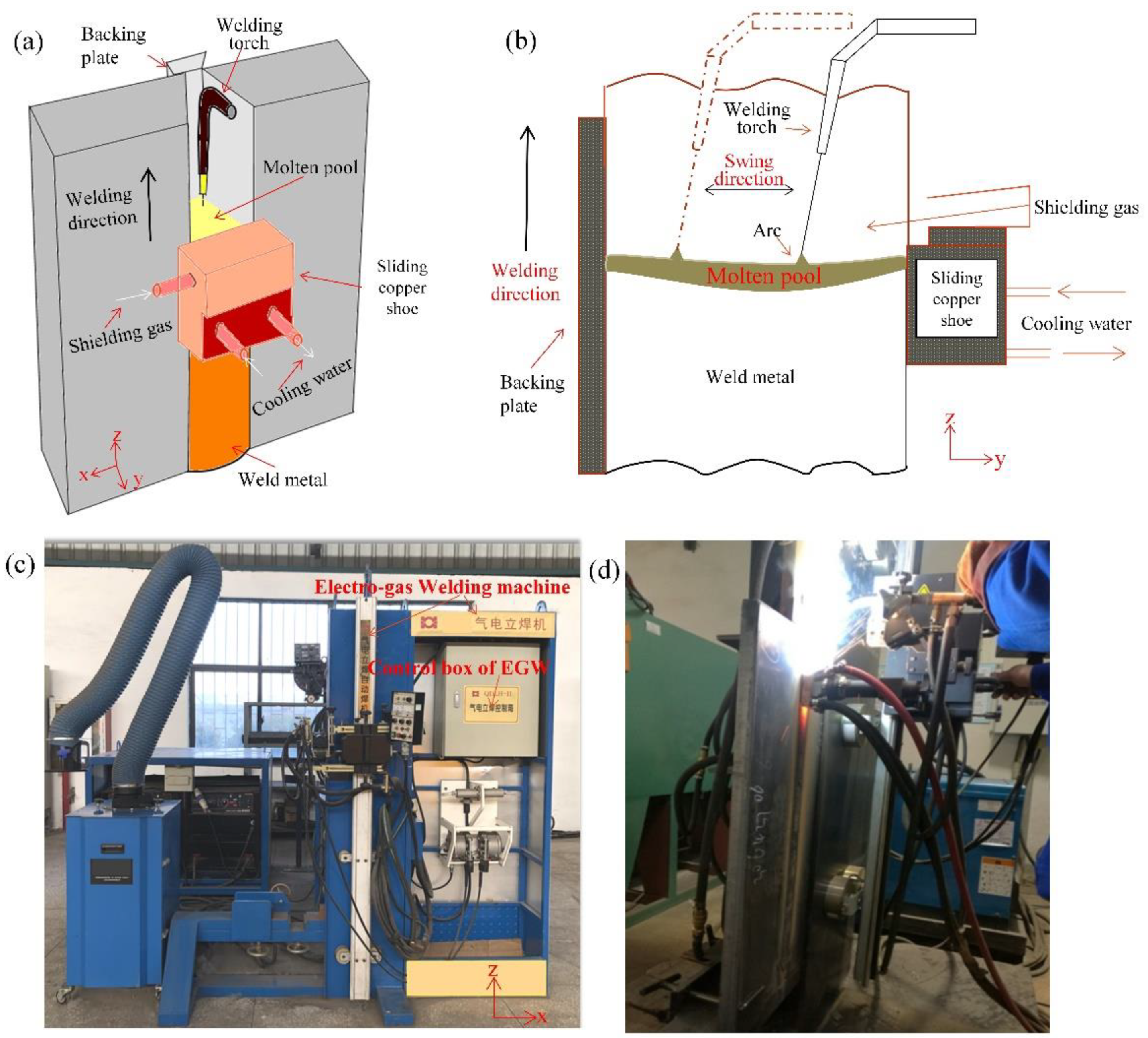



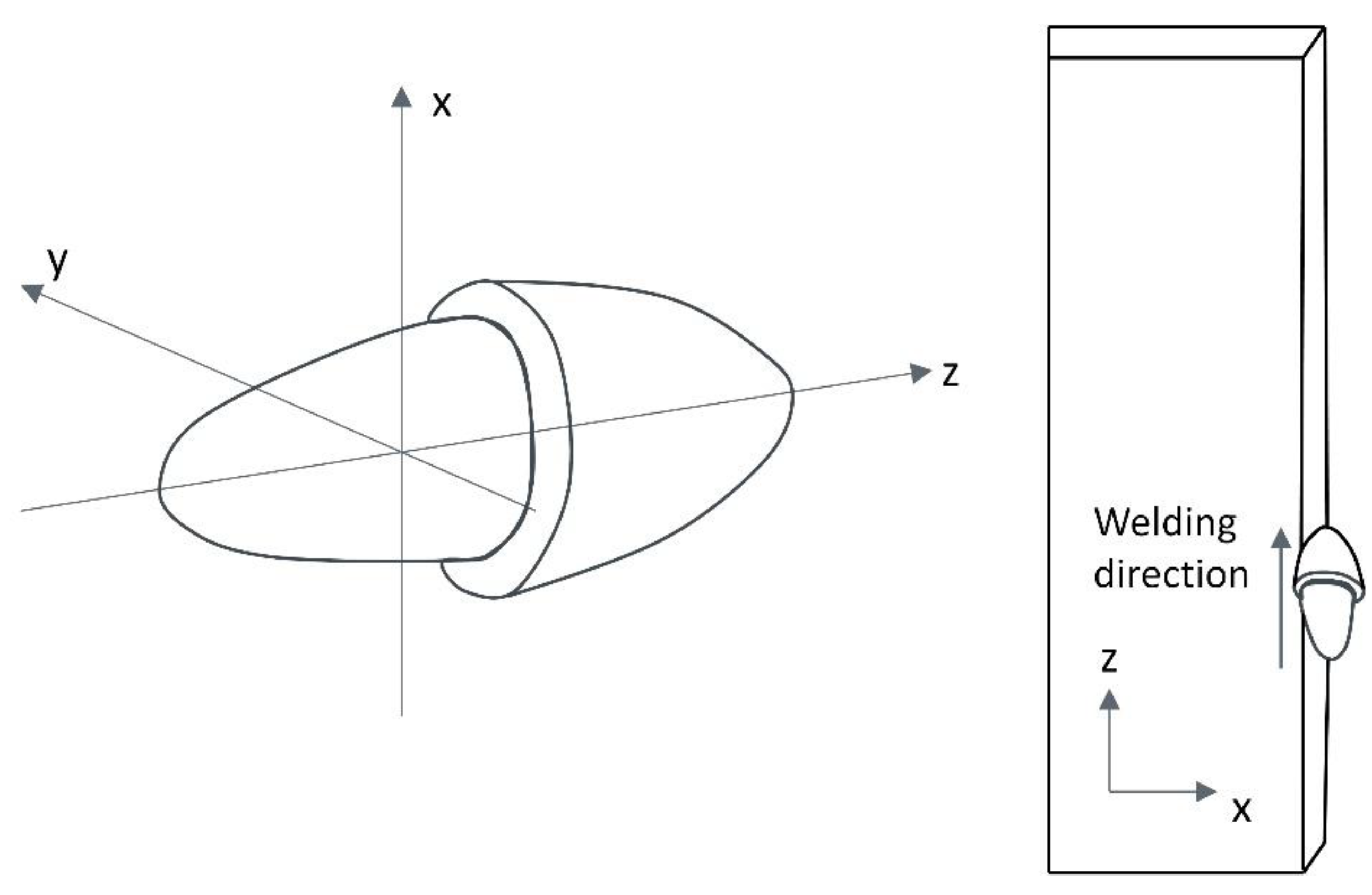


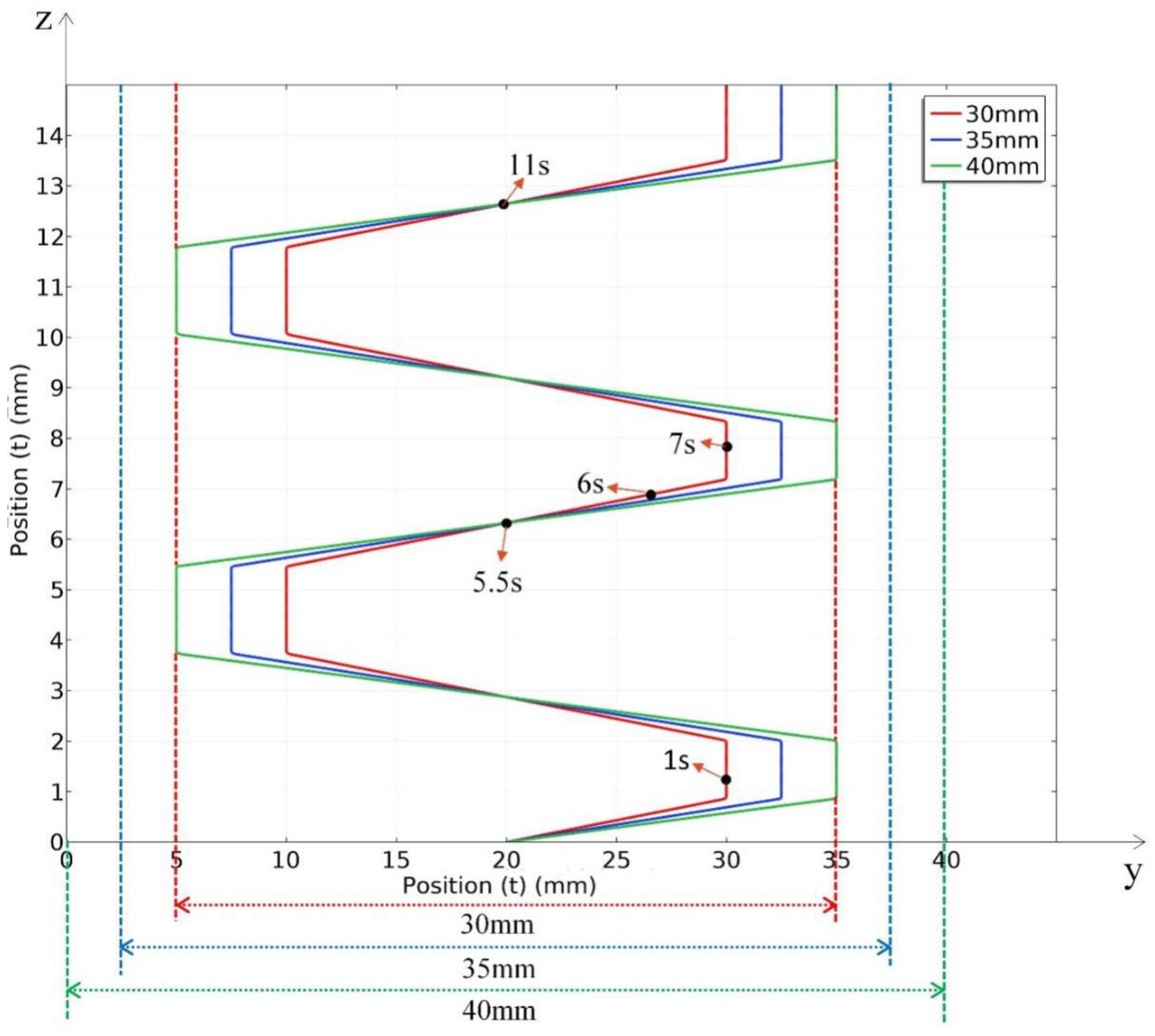
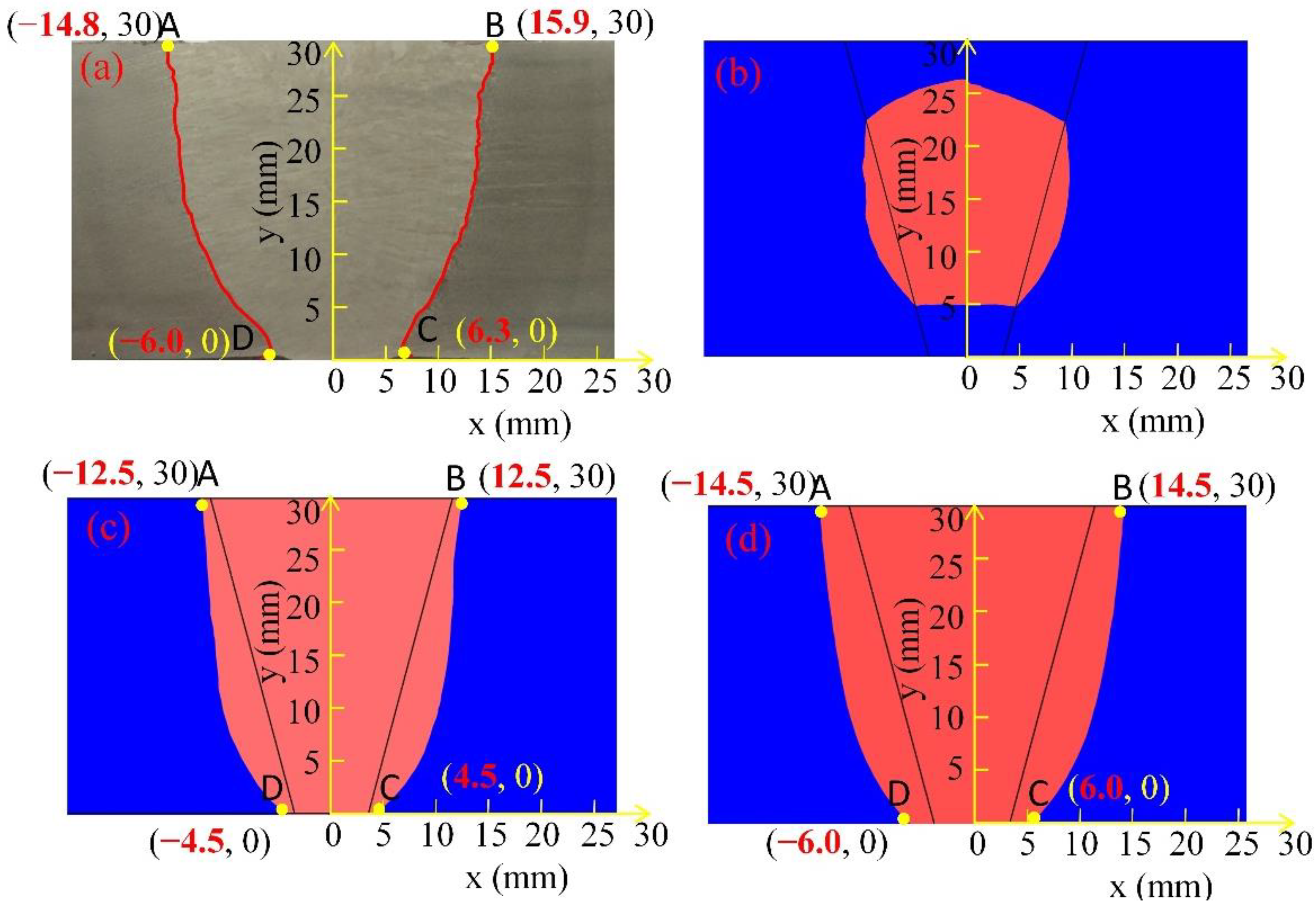

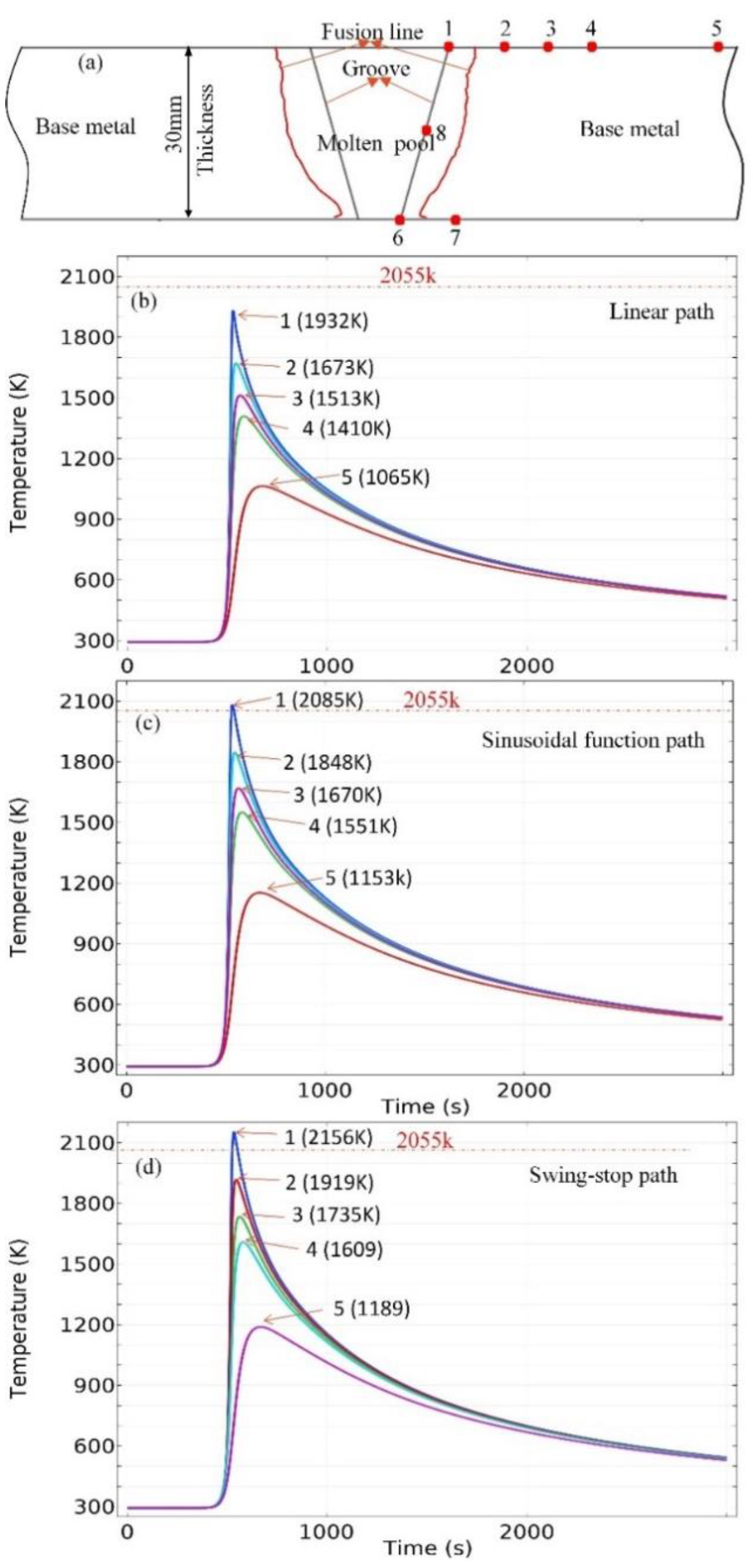

| Heat Input (kJ/cm) | Welding Speed (cm/min) | Current (A) | Voltage (V) | Wire Diameter (mm) | Wire Feed Rate (m/min) |
|---|---|---|---|---|---|
| 157 | 6.9 | 420 | 43 | 1.6 | 13 |
| Parameters of the torch movement of horizontal oscillations | |||||
| Internal stop (s) | External stop (s) | Amplitude (mm) | Frequency (s−1) | ||
| 1 | 1.5 | 10 | 2/11 | ||
| C | Si | Mn | S | P | Nb | Ti | Al |
|---|---|---|---|---|---|---|---|
| 0.08 | 0.27 | 1.45 | 0.002 | 0.01 | 0.014 | 0.014 | 0.034 |
| Grade | C | Mn | Si | S | P | Cr | Ni | Mo | B | Ti |
|---|---|---|---|---|---|---|---|---|---|---|
| DW-S60G | 0.07 | 1.68 | 0.33 | 0.006 | 0.011 | 0.02 | 0.77 | 0.26 | / | 0.02 |
| Yield Strength Rp0.2 (MPa) | Tensile Strength Rm (MPa) | Elongation A (%) | Akv at −20 °C (J) |
|---|---|---|---|
| 534 | 662 | 26 | 124, 139, 120 |
| No. | Thickness of Plate (mm) | Amplitude (A) (mm) | Period (T) (s) | Oscillate Range (mm) | Offset (k) (mm) |
|---|---|---|---|---|---|
| 1 | 30 | 10.0 | 5.5 | 20 | 20 |
| 2 | 35 | 12.5 | 5.5 | 25 | 20 |
| 3 | 40 | 15.0 | 5.5 | 30 | 20 |
| No. | Thickness (mm) | Internal Stop (s) | External Stop (s) | Oscillate Range (R) (mm) | Oscillate Center (C) (mm) | Period (T) (s) |
|---|---|---|---|---|---|---|
| 1 | 30 | 1.0 | 1.5 | 20 | 20 | 5.5 |
| 2 | 35 | 1.0 | 1.5 | 25 | 20 | 5.5 |
| 3 | 40 | 1.0 | 1.5 | 30 | 20 | 5.5 |
| Coordinate | Experiment (mm) | Linear (mm) | Error | Sinusoidal (mm) | Error | Oscillate-Stop (mm) | Error |
|---|---|---|---|---|---|---|---|
| A | (−15.9, 30) | × | × | (−12.5, 30) | 21.4% | (−14.5, 30) | 8.8% |
| B | (14.8, 30) | × | × | (12.5, 30) | 15.5% | (14.5, 30) | 2.0% |
| C | (6.3, 0) | × | × | (4.5, 0) | 28.6% | (6.0, 0) | 4.8% |
| D | (−6.0, 0) | × | × | (−4.5, 0) | 25.0% | (−6.0, 0) | 0 |
| Point | 1 (K) | 2 (K) | 3 (K) | 4 (K) | 5 (K) | 6 (K) | 7 (K) | 8 (K) | |
|---|---|---|---|---|---|---|---|---|---|
| Path | |||||||||
| Linear path | 1932 | 1673 | 1513 | 1410 | 1065 | 1810 | 1640 | 2420 | |
| Sinusoidal path | 2085 | 1848 | 1670 | 1551 | 1153 | 2021 | 1811 | 2295 | |
| Oscillate-stop path | 2156 | 1919 | 1735 | 1609 | 1189 | 2410 | 1960 | 2223 | |
Publisher’s Note: MDPI stays neutral with regard to jurisdictional claims in published maps and institutional affiliations. |
© 2022 by the authors. Licensee MDPI, Basel, Switzerland. This article is an open access article distributed under the terms and conditions of the Creative Commons Attribution (CC BY) license (https://creativecommons.org/licenses/by/4.0/).
Share and Cite
Fu, J.; Tao, Q.; Yang, X.; Nenchev, B.; Li, M.; Tao, B.; Dong, H. The Effect of Heat Source Path on Thermal Evolution during Electro-Gas Welding of Thick Steel Plates. Materials 2022, 15, 2215. https://doi.org/10.3390/ma15062215
Fu J, Tao Q, Yang X, Nenchev B, Li M, Tao B, Dong H. The Effect of Heat Source Path on Thermal Evolution during Electro-Gas Welding of Thick Steel Plates. Materials. 2022; 15(6):2215. https://doi.org/10.3390/ma15062215
Chicago/Turabian StyleFu, Jun, Qing Tao, Xiaoan Yang, Bogdan Nenchev, Ming Li, Biao Tao, and Hongbiao Dong. 2022. "The Effect of Heat Source Path on Thermal Evolution during Electro-Gas Welding of Thick Steel Plates" Materials 15, no. 6: 2215. https://doi.org/10.3390/ma15062215
APA StyleFu, J., Tao, Q., Yang, X., Nenchev, B., Li, M., Tao, B., & Dong, H. (2022). The Effect of Heat Source Path on Thermal Evolution during Electro-Gas Welding of Thick Steel Plates. Materials, 15(6), 2215. https://doi.org/10.3390/ma15062215







